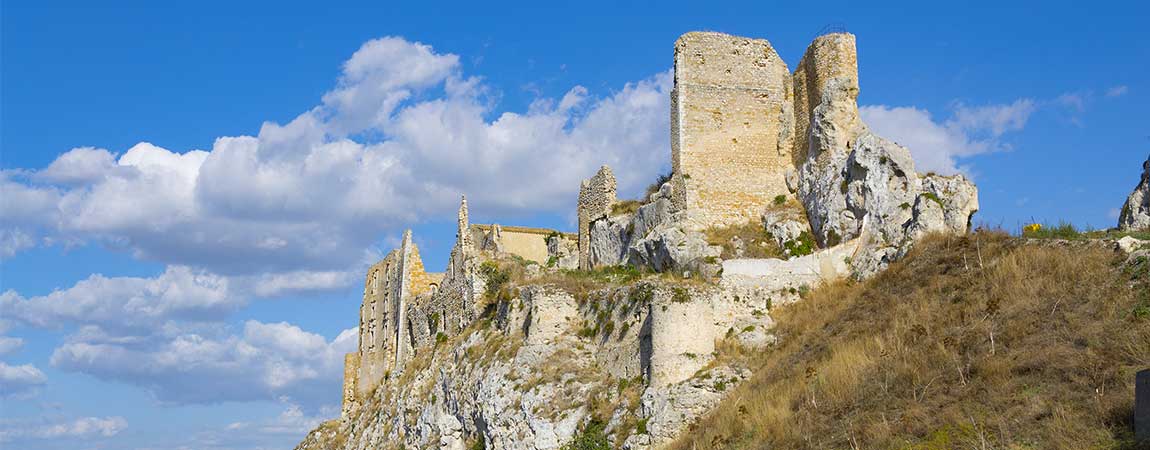
In the heart of Sicily, in the province of Enna, lies the small jewel village of Pietraperzia. It stands at an altitude of 476 meters on a rocky outcrop which dominates the beautiful valley of the Salso river and, as demonstrated by the pre-Hellenic cave tombs present in the rocky cavities at its feet, it stands in an area inhabited since very ancient times.
Not by chance the name of the village Sicilian comes from Petri Pirciari, which means exactly perforated stones.
Here the sacred and the profane merge, deeply felt religious holidays such as Easter rite de Lu Signuri of li Fasci and legends full of tragedies, such as the one concerning the now lost Barresio Castle of Pietraperzia.
The ancient Barresio Castle in Pietraperzia
Finding ourselves today in the presence of the vestiges of the Pietraperzia Castle, it is hard to believe that in the past this ruined building was one of the most elegant residences in all of Sicily. The castle bears the name of its historic owner family, i.e. the Barresi: although the original nucleus dates back to 1060, its grandest image is linked to Giovanni Antonio Barresi. In fact, the man wanted to give his wife, Laura Sottile, a sumptuous and rich residence.
It is said that the Castello di Pietraperzia had 365 rooms, as many as there are days in the year: it also seems that the rooms were distributed over four floors (four like the seasons) and that 12 towers soared from the elegant crenellated walls of the castle, many how many months are there?
Carelessness and earthquakes have made the castle now a ruin from the top of a rocky fortress 549 meters high overlooking the Imera river valley. At first it enchanted those who were lucky enough to see it, despite the fact that the fortress had already had a troubled history: in fact, think of when in 1283 the Barresi, after siding with the Aragonese against the D'Angiò, then turned against them, bringing the same Aragonese to destroy the castle. Only in 1320 did the Barresi manage to regain the feud of Pietraperzia and, with it, dominion over the castle.
Nothing remains of the ancient splendor, except the crenellated tower Corona del Re, the fourteenth-century quadrangular tower commissioned by Abbo IV Barresi and a few bastions that punctuated the more than 1 km long walls. In the light of the legend that surrounds it, the Barresio Castle today has its own beauty, remote and sinister, to be discovered.
The legend of Pietraperzia and its castle
Like almost every castle in the world, even that of Pietraperzia has its sad legend, which is placed approximately during the reign of Frederick II of Swabia (therefore between 1194 and 1250).
The stories tell that one day three girls decided to enter the dungeons of the Castle, with the hope of finding a treasure or in any case some valuable object. Since the prisons were very large and extensive, the women brought with them a candle each and a string: this thread would have allowed them to sneak into the darkness of the dungeons without getting lost.
The girls gave life to a sort of procession of light and for a while things proceeded smoothly: suddenly, however, one of the women was distracted by a glint in a dark corner and the candle she was carrying set fire to the string that tied her to other women. Without their "Arianna's thread", the three girls remained in the dungeons of the Barresio Castle without being able to leave it: being aware of this legend makes the ruins of this castle with a grandiose past even more sinister, perhaps thinking of desperate souls of those women buried alive in the basement.
Pietraperzia holds many others legends, in addition to that of the Barresio Castle and one of these concerns the Sanctuary of the Madonna della Cava, located in the countryside district of the same name. In fact, it is said that the church was born on the site where in 1223 a young mute shepherd boy found, in a cave, the effigy of the Virgin affixed to the stone. As soon as he had the vision, the pastor regained his speech and ran to warn the citizens of Pietraperzia and the priests: they all tried to get the miraculous painting, but with every effort the effigy broke, recomposing itself immediately afterwards. It was the divine sign that the image of the Madonna was to remain in that place, where in fact the sanctuary was later erected.
Those who want to visit the Barresio Castle cloaked in the sad legend of the three buried maidens, just have to reach Pietraperzia, perhaps opting for the period of Holy Week thus enjoying the evocative rite of Lu Signuri of li Fasci.
© Image by Antonio Francesco6162, CC BY-SA 4.0, via Wikimedia Commons









